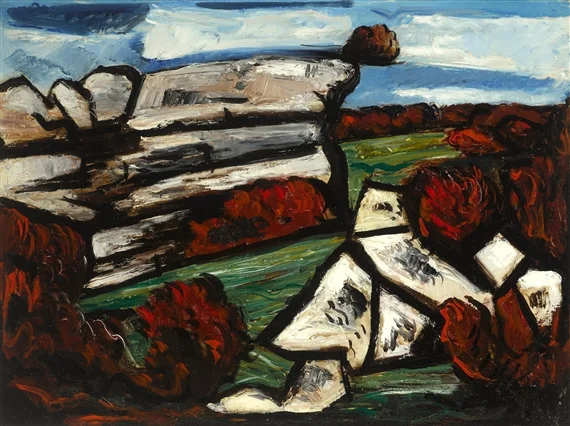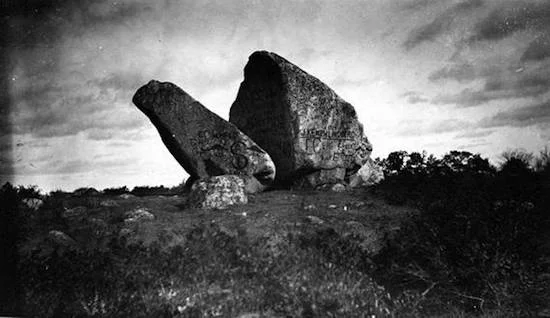
A 'mystical and magical' land on Cape Ann
“Red Landscape #1, Dogtown,” (acrylic on canvas), by Ed Touchette, at the Cape Ann Museum, Gloucester, Mass. Gift of the artist, given in memory of Dana Todd.
The museum notes:
“The 3,000-acre swath of boulder-strewn land that makes up the center of Cape Ann has been known as Dogtown for generations. Since the disappearance of the last glacier, the area has undergone many iterations—from inhabitation by Native American groups and subsequently Colonial settlers to a sparse population of those on the fringes of society—and a slow but steady reversal of pasture lands back to the woodlands that are experienced in this protected green space today. Despite these changes, Dogtown remains mystical and magical, a sanctuary from its busier surroundings, a place for quiet thought and a reunion with nature. Read on as we explore its history and impact as a vast expanse of land that endures as both a resource and a challenge for the people of Cape Ann.’’
'Druidic' Dogtown
Dogtown, on Cape Ann, in 1908.
''The place (Dogtown, in Gloucester, and Rockport, Mass.) is forsaken and majestically lovely as if nature had at last formed one spot where she can live for herself alone.. (it) looked like a cross between Easter Island and Stonehenge -- essentially druidic in it appearance, it gives the feeling that an ancient race might turn up at any moment and renew an ageless rite there.''
-- Marsden Hartley (1877-1943, modernist painter, poet and essayist), one of whose paintings of Dogtown is below, as is a brief history of the place.
The ghost town known as Dogtown is divided between Gloucester and Rockport. Dogtown was first settled, as a farming village, in 1693, with the name said to develop much later from dogs that women kept while their husbands were fighting in the American Revolution. In the mid-1700s as many as 100 families inhabited Dogtown, which was stable until after the American Revolution.
Most of the farmers in Dogtown moved away by the end of the War of 1812 and the area became known for its rather creepy beauty and huge boulders.
Beautiful land, in a way
"Whale's Jaw, Dogtown,'' from the archives of the Cape Ann Museum, in Gloucester.
"Whale's Jaw, Dogtown,'' from the archives of the Cape Ann Museum, in Gloucester.
Dogtown is an abandoned inland settlement on Cape Ann. Once known as the Common Settlement and populated by respectable citizens, the area later known as Dogtown is divided between Gloucester and Rockport. It's in an area not well suited to agriculture, because of poor and very rocky soil. It's not all that great for building either. You need a lot of dynamite.
The boulders above, of course, came from what is now Canada in the last Ice Age.
The look of such landscapes is chilling, even in summer. The whaling reference is to be expected in coastal New England.



